Ijraset Journal For Research in Applied Science and Engineering Technology
- Home / Ijraset
- On This Page
- Abstract
- Introduction
- Conclusion
- References
- Copyright
Performance of Wind Turbine with Magnetic Levitation
Authors: Dr. Duppala Azad, Dokkara Sri Sai, Kondra Ramakrishna, Panduru Raviteja, Kambala Gowtham, Runku Kranthi Kumar
DOI Link: https://doi.org/10.22214/ijraset.2023.50688
Certificate: View Certificate
Abstract
A Maglev wind turbine is a new and innovative technology that has been developed to harness wind energy efficiently. Unlike traditional wind turbines, Maglev turbines use magnetic levitation to rotate the blades without the need for mechanical bearings. This approach has several benefits, including reduced friction, lower maintenance costs, and increased durability. The Maglev wind turbine technology is still in the experimental stage, but it has the potential to revolutionize the wind energy industry by providing a more reliable and efficient way to generate electricity from wind power.
Introduction
I. INTRODUCTION
Wind energy has emerged as a promising alternative to traditional sources of electricity. However, traditional wind turbines have some inherent limitations, including high maintenance costs and low efficiency. The Maglev wind turbine has been developed as a solution to these issues by employing magnetic levitation to support the blades and increase the efficiency of the turbine. This new technology offers numerous advantages over traditional wind turbines, including lower maintenance costs, higher durability, and increased efficiency. This introduction provides an original overview of the Maglev wind turbine technology and its potential to revolutionize the wind energy industry.
II. LITERATURE REVIEW
Aravind CV et al.,[2012] carried design procedure and analysis of vertical axis wind turbine using magnetic levitation where gears were replaced with direct drive technology, thereby reducing the maintenance and power loss. Bearing were replaced with magnetic levitation. From the analysis he concluded that replacing magnets with bearings to the VAWT increases the efficiency and reduces the vibration by 30% compared to that of the turbine without mechanical bearing.
Dinesh N Nagarkar et al.,[2013] carried out study on construction and working of magnetic levitation based power plant which has colossal structure where blades were placed vertically along the outer rim of the cylinder. Since the total assembly was levitated by permanent magnets so there was no friction. The magnets allowed the wind turbine to convert all the wind energy into electrical energy which results in increasing output and reducing cost.
Minu John et al.,[2014] carried out an experimental study on vertical axis wind mill working on maglev using Nd-Fe-B ring shaped permanent magnets of grade N-42 of outer diameter 40 mm, inner diameter 20 mm and thickness 10 mm placed at the centre of the shaft by which the required levitation between the stator and the rotor was obtained. Similar disc type magnets of 30 mm diameter and 4mm thickness were arranged as alternate poles one after the other, along the periphery of the rotor made of acrylic of 40mm diameter. 26 gauge wires of 1000 turns each were used as coils for power generation. 12 sets of such coils were used in the prototype and were arranged in the periphery of the stator exactly in a line to the arranged disc magnets. The output voltage obtained from this prototype was a maximum of 45 volts DC.
B. Bittumon et al., [2014] carried out research on combined savonius and darrieus rotors which is very scarce. He designed and analysed a Maglev VAWT using a combined savonius and darrieus vertical axis wind turbine would have many advantages over an individual savonius or darrieus rotor. A savonius produces high torque which would be useful in self-starting and darrieus rotor having a high tip speed ratio useful for electrical generation. This developed a two bucket savonius rotor and placed it on the central shaft of a traditional darrieus. Using a counter rotating wind turbine with a freely rotating generator can produce higher amounts of power than common wind generators.
Amit D. Patil et al., [2015] designed a prototype model of a VAWT using magnetic bearing. The rotors that were designed harnessed enough air to rotate at low and high wind speeds while keeping the centre of mass closer to the base yielding stability. The wind turbine rotor levitated properly using permanent magnets, which allowed for a smooth rotation with negligible friction. 4 blades rotor is selected to use in this project. Other components which is mounted on the base are emf generator, charging circuit, battery. The output voltage obtained from this prototype is measured using a multi-meter and a maximum of 5volts DC was obtained.
III. OBJECTIVES OF THE PRESENT WORK
The main objective of the present work is to fabricate a working model maglev wind turbine and to test it’s performance under different wind speeds and number of turns in coil.
The specific objectives of MWTs can be summarized as follows:
- Improved Efficiency: MWTs should achieve higher wind energy conversion efficiency compared to traditional wind turbines. It can be achieved through the use of magnetic levitation technology.
- Increased Reliability: MWTs aim to improve reliability by reducing the number of moving parts and eliminating the wear and tear associated with mechanical bearings.
- Lower Noise Levels: MWTs aim to reduce noise levels associated with wind turbines, through eliminating mechanical bearings which generate noise.
- Reduced Maintenance Costs: MWTs aim to reduce maintenance costs by eliminating the wear and tear associated with mechanical bearings.
IV. METHODOLOGY
The Maglev wind turbine utilizes magnetic levitation to suspend the turbine blades and rotate them without the need for mechanical bearings. The technology is based on the principle of magnetic repulsion, whereby two magnets of the same polarity will repel each other. In the case of the Maglev wind turbine, the blades are fitted with magnets that are suspended above a magnetic stator, creating a repulsive force that enables the blades to rotate. The magnetic levitation system allows the blades to rotate with minimal friction, resulting in increased efficiency and reduced maintenance requirements. To achieve stable magnetic levitation, the Maglev wind turbine utilizes advanced control systems that regulate the magnetic field to maintain a constant gap between the blades and the stator. These control systems use sophisticated algorithms to adjust the magnetic field in real-time, ensuring that the turbine remains stable and efficient even in high winds. The design of the Maglev wind turbine is still in the experimental stage, and researchers are continuously working to refine and improve the technology. Testing of the Maglev wind turbine has been carried out in various locations worldwide to assess its efficiency and durability under different wind conditions.
Overall, the methodology for the Maglev wind turbine technology involves the utilization of magnetic levitation, advanced control systems, and ongoing testing and refinement to achieve increased efficiency, reduced maintenance, and increased durability compared to traditional wind turbines.
V. COMPONENTS OF MAGLEV WIND TURBINE
- Blades of Rotor: We used savonius type blades in this maglev wind turbine. Savonius blades which are arranged around the vertical shaft within a helix form. These blades mainly rely on the mechanism of flow resistance to make the rotor active which means, the dynamic force of the wind against the turbine blades thrust the rotor into revolution. Simultaneously, the reverse side of the blades meets an aerodynamic resistance force. Because of this, these blades can turn with wind speed. Figure.1 illustrates the picture of blades of rotor. The blade is made up of galvanized iron of thickness 0.8 mm. The blade material consisting modulus of elasticity of 200GPa and poisson’s Ratio of 0.29. The blades are trapezoidal shape of height 60cm and mean width of 30cm. The blades are curved inwards to form a semi circular shape.

2. Neodymium Magnets: Neodymium magnets are used in this maglev turbine. Neodymium magnets are permanent magnet made from an alloy of neodymium, iron, and boron. Neodymium magnets of 30mm diameter and a height of 5mm. It has a magnetic flux of 1913 gauss and a pull force of 9.8kgs. We are using 20 such magnets to create levitation effect. These 20 magnets are arranged in circular order from the shaft on both upper and lower plane with same poles facing each other. The distance between these planes are 4cm.
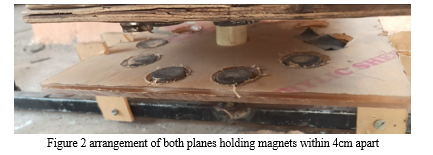
3. Centre Shaft: UPVC pipe is used as centre shaft. Centre shaft is a hollow pipe of 30mm outer diameter and 25 mm inner diameter with 80cm height. UPVC pipe is having tensile strength of 52 MPa and elastic modulus of 3000 - 4000MPa.
4. Supporting Plane: one wooden plywood board and fibre dimensions 45cm × 50cm × 1.5cm are used as supporting planes.
5. Winding Coil: Eight Copper Winding coils of gauge diameter of 0.0635mm and 1000 turns are used. The resistance offered by a single coil is 5Ω. these 8 coils are placed in between the two planes. The coils used are as shown in the figure below.
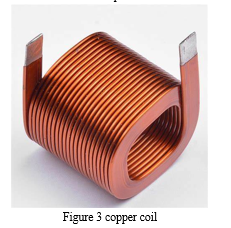
V. WIND POWER GENERATION
1) Design of Shaft: The Savonius type blades are used in this Maglev turbine. Savonius type turbine is rugged and simple in construction. The making of these type of blades are easier, less maintenance is required and also the adaptability to harsh conditions. The number of blades used depends on the type of construction and the operation of the windmill. When the blades used are more, weight of the turbine, the swept area of turbine and the turbulence of the turbine will be more. When the number of blades used is less, then the area swept by the turbine is also less. So, the number of blades used should depend on these factors. This working model consists of two blades placed such that the angle between the two blades is 180 degrees. All the blades are attached such that all the blades are tilted at 10 degrees. Mainly the blades are made to be at an angle somewhere between 30 – 45 degrees so as the blades will encounter more wind and will rotate with high speed.
The output power of the turbine depends upon some physical parameters such as speed of the wind, generator’s mechanical speed and the Tip speed ratio of the turbine. For a wind turbine the Tip speed ratio is the ratio of tangential speed of the blades to the actual wind speed.

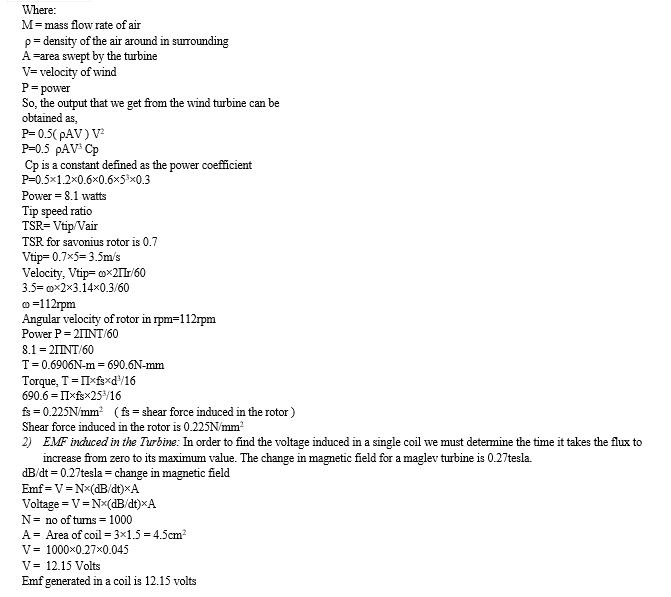
VII. ADVANTAGES OF MAGLEV TURBINE
Maglev wind turbines (MWTs) offer several advantages over traditional wind turbines, including:
- Higher Efficiency: Maglev wind turbines can achieve higher efficiency due to their use of magnetic levitation technology, which reduces friction losses and allows for smoother operation.
- Increased Durability: The elimination of bearings in Maglev wind turbines leads to less wear and tear, reducing the need for maintenance and increasing the lifespan of the turbine.
- Lower Noise: Maglev wind turbines are generally quieter than traditional turbines due to their use of magnetic levitation, which eliminates the need for mechanical components that generate noise.
- Scalability: Maglev wind turbines are highly scalable and can be built in a variety of sizes, making them suitable for a range of applications from small-scale residential use to large-scale commercial power generation.
VIII. RESULTS AND DISCUSSION
Fabricated a working model Maglev wind turbine and done various tests on it’s performance under different wind speeds and number of turns in coil.
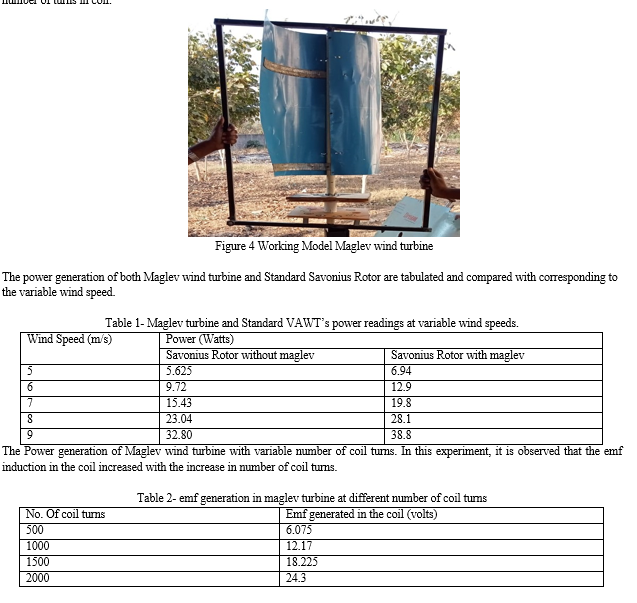
Conclusion
In conclusion, maglev wind turbines offer several advantages over traditional wind turbines. With their magnetic levitation technology, they have the potential to be more efficient, require less maintenance, and have a longer lifespan. They are also quieter and safer than traditional wind turbines, and their smaller size makes them more versatile and easier to install in urban or suburban areas. Additionally, they are a renewable energy source, which means they do not contribute to greenhouse gas emissions or air pollution. As such, maglev wind turbines are a promising alternative to traditional wind turbines and could play a significant role in the future of renewable energy production.
References
[1] Li, H., Li, H., Li, X., Li, Q., & Li, C. (2020). Experimental investigation of a maglev wind turbine with a novel blade structure. Renewable Energy, 146, 2461-2470. [2] Zhang, X., Chen, Z., Zhu, Y., & Chen, Y. (2019). Design and analysis of a vertical axis maglev wind turbine with air core generator. Applied Energy, 239, 1074-1087. [3] Klimczak, P., ?muda-Trzebiatowski, P., & K?os, K. (2019). Performance analysis of a maglev wind turbine with permanent magnets. Journal of Physics: Conference Series, 1359(1), 012078. [4] Tian, L., Liu, S., Liu, J., & Jia, H. (2019). Modeling and simulation of maglev wind turbine with permanent magnet synchronous generator. International Journal of Electrical Power & Energy Systems, 107, 582-592. [5] Han, L., Xue, X., & Wang, W. (2018). A review of maglev wind turbine technology. Renewable and Sustainable Energy Reviews, 81, 2168-2184. [6] Chandulal Guguloth, A.T Gapat, D.C Shende, S.P More, A.G Dandekar. Power Generation using Maglev Wind Turbine.(NCMTEE-2017). [7] B. M. Preetham, Rohit Pratap Singh, Srisharan Sindhe S, Vishal Yadav. Maglev Windmill. International Advanced Research Journal in Science, Engineering and Technology Vol. 4, Special Issue 7, May 2017. [8] Chinnu Sara Thomas, Dhanya Varghese, Jayalakshmi S, Sonu Savy, Thomas George, Rini Varghese (2016). “ Magnetically Levitated Wind Turbine for Power Generation”, International Journal of Advanced Research in Electircal, Electronics and Instrumentation Engineering,ISSN:2320-3765. [9] Amit D Patil, Amit W Chake, Manoj J Helonde, Pravin M Gupta, “Vertical Wind Turbine With Technology” International journal for scientific research and development VOL-2, ISSUE-12,2015. [10] Vishal D Dhareppgoal and Maheshwari M Konagutti,” REGENEDYNE Maglev Wind Power Generation”, SARC-IRAJ International Conference, 16th June 2013, Pune, India, ISBN: 978-81-92747-8-3.
Copyright
Copyright © 2023 Dr. Duppala Azad, Dokkara Sri Sai, Kondra Ramakrishna, Panduru Raviteja, Kambala Gowtham, Runku Kranthi Kumar. This is an open access article distributed under the Creative Commons Attribution License, which permits unrestricted use, distribution, and reproduction in any medium, provided the original work is properly cited.
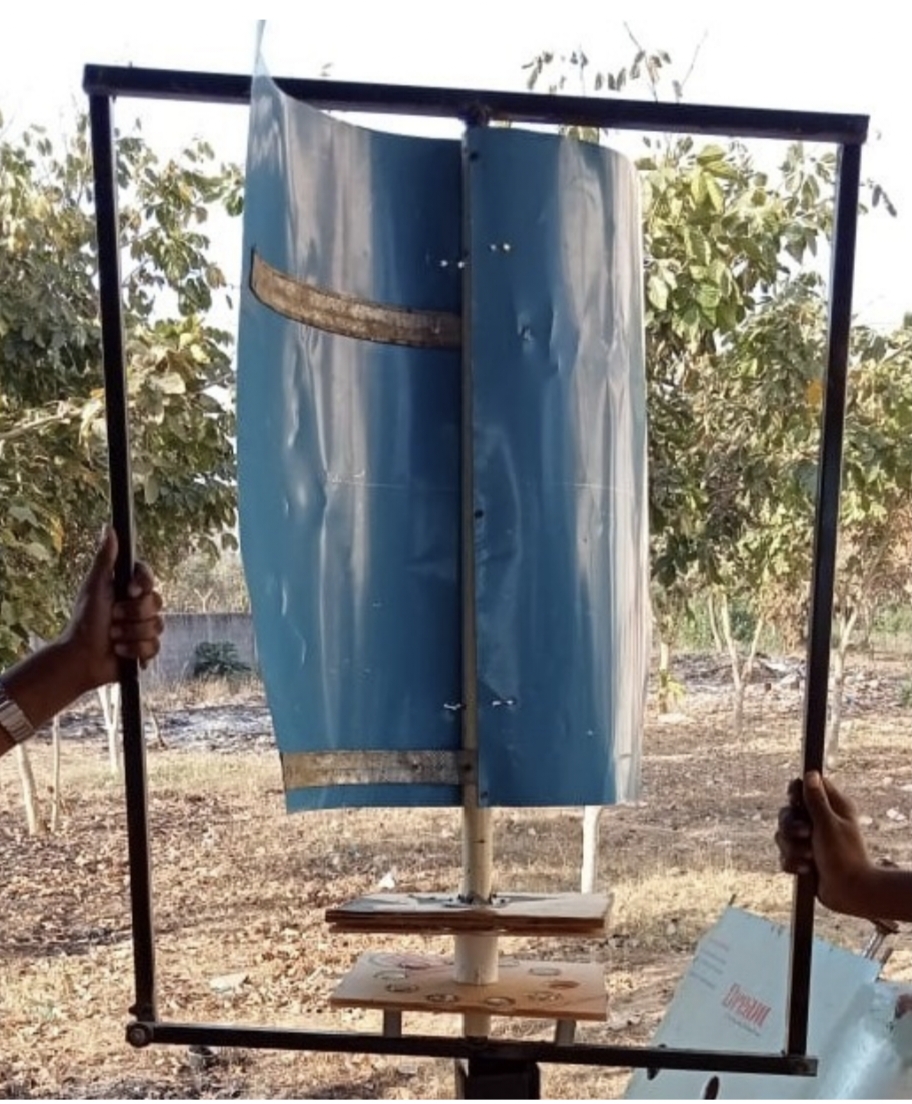
Download Paper
Paper Id : IJRASET50688
Publish Date : 2023-04-20
ISSN : 2321-9653
Publisher Name : IJRASET
DOI Link : Click Here
 Submit Paper Online
Submit Paper Online

